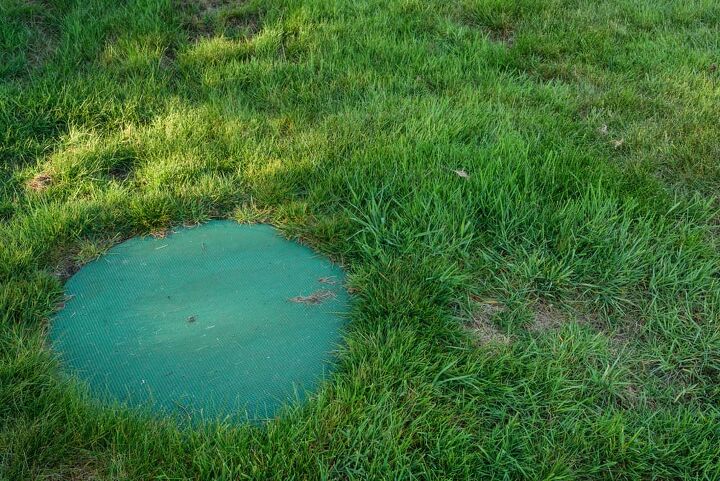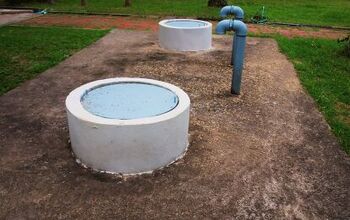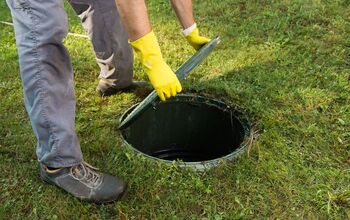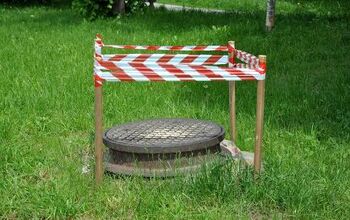How To Find A Septic Tank Lid (Quickly & Easily!)

Do you know where your septic tank is? It’s probably not a question you’ve pondered too often, but it’s one you definitely need an answer to. You could run into some problems if you remain unaware of exactly where your septic tank is located. Thankfully, finding the septic tank on your property is an easy enough undertaking. It all starts with finding the lid of your septic tank.
The most reliable way to find the septic tank and its lid involves consulting the site plan for your property first. After consulting the site plan, you should have an idea of where the lid is so search around that spot. Using a metal detector can help you find the lid faster while a shovel can help uncover it.
It’s important to know precisely where your septic tank is located at all times. Continue with this article to learn more about pinpointing the location of your septic tank on your property.
Do You Need a Septic Tank Cleaning or Pumping Service?
Get free, zero-commitment quotes from pro contractors near you.

The Reasons Why Knowing the Location of Your Septic Tank Matters
The septic tank is a part of the home that many folks simply don’t think about unless it starts having issues. Most of the time, being unaware of the septic tank’s location is not going to be a big deal. However, there are times when knowing the location of your septic tank is important. Let’s discuss some of those scenarios below.
Building Safely
Knowing the location of your septic tank is important if you’re planning to build something big on your property. Let’s say that you want to build a garage.
You’re so excited by the idea of your new garage that you start building without looking over your home’s layout first. Because of that, the new garage is now directly over your septic tank. With the garage now over your septic tank, you won’t be able to drain the latter easily. On top of that, there’s a chance that you’ll break the tank’s lid if you’re constantly driving cars over it.
You may have to demolish your newly built garage because it is situated over your septic tank. The investment you made into that garage will be wasted simply because you couldn’t be bothered to locate the tank first.
Early Problem Detection
You should also know the location of the septic tank’s lid for the purposes of problem detection. Septic tanks are not immune from having issues. Some of those issues may present symptoms that you’re unable to detect immediately because you don’t know where the tank is.
By the time you notice the problem, it may already be too late. Your septic tank may have already sustained too much damage. It’s important to check on the septic tank regularly and knowing where the lid helps with that.
Easy Maintenance
Homeowners should also be vigilant when it comes to septic tank maintenance. You do not want that element of your home to go without maintenance for any extended period of time.
Being aware of the septic tank’s location can help you remember to check up on its maintenance. Plus, having the lid right there makes it easier for the professionals to care for your tank. Maintenance can be performed easily if you know where the septic tank is.
How Many Lids Does Your Septic Tank Have?
Homeowners who aren’t familiar with septic tanks may assume that there’s only one lid to look for. That may not be the case though.
Only the older septic tanks rely on one lid. For reference, the older septic tanks we’re discussing here are ones that were installed during the early 1970s.
If you have a newer tank, it should be equipped with at least two lids. Those lids are also typically made out of either fiberglass or polyethylene. Newer septic tanks have more lids because more chambers need to be covered. They usually feature a more complex design than their older counterparts.
Finding the Septic Tank Lid
It’s now time for us to talk about finding the lids of your septic tank. This usually turns out to be an easy job especially if you have a metal detector you can use. Let’s get to the detailed steps below.
Step 1: Examine the Site Plan of Your Property
The first thing you must do if you want to find your tank’s lid is to reference your property’s site plan. You may have received the aforementioned site plan when you first bought your home.
Don’t worry if you lost that site plan. You can still head over to your local county building department and search for your property’s site plan there. With the site plan in your possession, you should be able to see precisely where the tank is installed. The diagram will likely even indicate how many lids it has.
Step 2: Use the Site Plan as a Reference
Go back to your property now and start using the site plan as your reference for finding the lid. Look closely at the ground to see if you spot anything resembling a lid down there.
You can also use a metal detector to make the search easier. It should be able to detect the metal components of the tank and point you in the direction of the lid.
Optional Step: Uncover the Septic Tank Lid
Some homeowners may be able to find the septic tank lid immediately after using the site plan and a metal detector. However, some may have a hard time spotting the lid even if the diagram says they’re standing right over it.
The reason why you may not be seeing the lid is because it’s buried. Grab a shovel and start digging in the spot where the diagram says the lid is. You may not have to dig that long to find the septic tank’s lid. Septic tank lids are normally set in the range of four inches to four feet deep into the ground.
Alternative Methods of Finding the Septic Tank Lid
Use the Sewer Line and Probes
You may not have the site plan for your property on hand. Going to the county building department to find the plan may also not be an option if there’s an urgent issue.
So, what should you do in that scenario? The answer is to look down. Head down to your basement or crawlspace and look for the sewer line there. Take a close look at the sewer line and note where it exits your home.
Move outside now and stick a probe near the spot where the sewer line is. Continue moving along the length of the sewer line and use probes along the way. Eventually, the probe will hit something flat. Hitting that flat spot means you’ve likely found the septic tank lid. You can start digging at that point to uncover the lid and check up on the septic tank.
Call the Professionals
You should also remember that calling the professionals for assistance remains an option if you’re dealing with your septic tank. They should have no trouble finding where the tank is on your property. Hiring the professionals is also necessary if the tank needs to be opened.
Do You Need a Septic Tank Cleaning or Pumping Service?
Get free, zero-commitment quotes from pro contractors near you.

Related Questions
How Do You Hide the Septic Tank Lid?
The septic tank’s lid could be messing up your landscaping. You don’t want attention being drawn to that cover instead of the other more beautiful features of your yard. To prevent the septic tank lid from taking over your outdoor landscape, you will need to hide it.Hiding the septic tank’s cover is pretty easy. You can use tall plants to keep the lid shielded from view. Tall grasses may be enough to do the job. You can also cover the lid using items such as lid covers or artificial rocks. Even pots for plants can be placed over the lid as long as they are light enough.
How Long Can You Expect Your Septic System Last?
Assuming proper maintenance and care, your home’s septic system can last for up to 40 years. The material makeup of your septic tank impacts its longevity as well.The concrete and plastic tanks are known for their exceptional longevity and they can hit the 40-year mark pretty consistently. Steel septic tanks have the strength to last for a long time, but rust often compromises their durability.

Gary Evans is passionate about home improvement. He loves finding out how to make improvements in the easiest, most practical, and most affordable ways. Upgrading his home kitchen is one of his ongoing hobbies. Gary is also a long-time content creator and enjoys spending his free time tending to his hydroponic vegetable garden.
More by Gary Evans



























